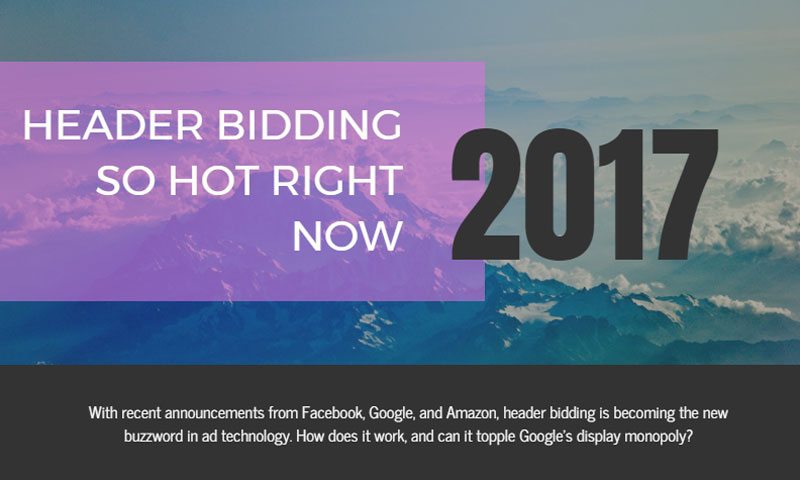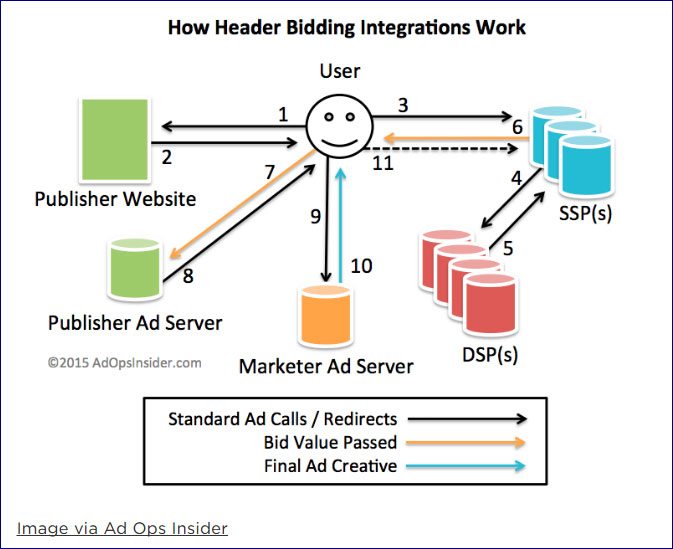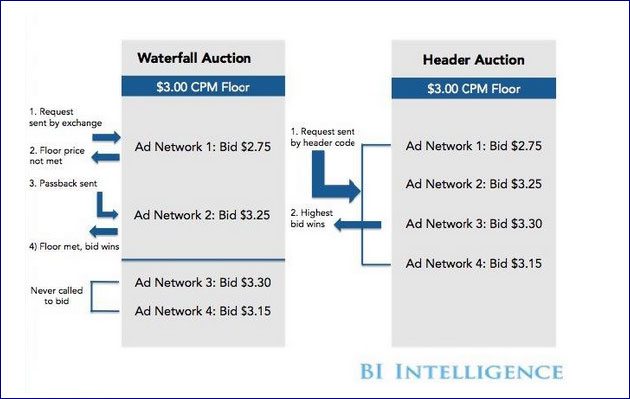Is Header Bidding Threatening Google’s Display Ad Monopoly?

I’ve been scouring the Internet, looking for any and all insight on the latest buzzword in the ad tech industry: header bidding. What I’ve found is a collection of charts and graphics that leave me more confused than when I started. And when there aren’t charts to throw me off, I’m often left with insular jargon that can’t be deciphered without an advanced understanding of display advertising. And the acronyms. So many acronyms. Here’s an example of a graphic replete with numbers, shapes, color-coded arrows, the aforementioned acronyms, and a dotted arrow left unexplained by the legend:

All of this complaining is not just to put an ice pack on my ego. It’s to highlight the complexity of the programmatic landscape – to let you know that you’re not alone. This stuff is confusing. Luckily for me, I have the advantage of consulting with our display experts here at Location3, who can break it down into simpler concepts and explain why header bidding matters. Let’s start with the basics:
What Is Header Bidding?
Header bidding refers to a programmatic advertising model that allows publishers to receive multiple bids simultaneously with the highest bid gaining access to the publisher’s ad inventory. This tactic is designed to maximize ad revenue for publishers and grant media buyers access to premium inventory.
A Brief History of Header Bidding
Before we explain how header bidding came to the forefront of the ad tech industry, we need to know what came before. The process that preceded header bidding was often referred to as the “waterfall”.
In a waterfall auction, the publisher receives individual bids on their inventory based on previous relationships with demand sources (ad networks/exchanges). If the publisher is not satisfied with the top-ranked source’s bid, the inventory is then passed on to the next highest-ranked source. While publishers are able to sell all of their inventory through the waterfall, they fail to sell all of their inventory at its highest potential price.
This inefficiency led to the development of header bidding all the way back in 2009, when AppNexus introduced the product to little fanfare. But as publishers have become more savvy, we’ve seen header bidding jump into the spotlight by providing hope for a selling process that benefits all players. This graphic is the most accessible representation of the relationship that I’ve seen:

As we see in the graphic, the simultaneous bidding associated with header auctions benefits publishers by allowing the highest bidder to win, regardless of source ranking.
So how does it benefit media buyers? Location3 Head of Display Robin Arlen explains: “What header bidding will do for advertisers is give them easier access to premium inventory, and they won’t necessarily have to place private marketplaces or direct buys to have access to that inventory.”
So What’s the Big Deal?
If header bidding has been around since 2009, why has it taken 8 years to come to the surface? Well, because all of the market’s biggest players are ready to sit at the table.
As previously mentioned, Google has dwarfed the competition for years when it comes to ad technology. For example, in September 2013, Google served 300 billion ad impressions, according to Evidon. The next nearest competitor? OpenX with just 84 billion impressions.
But just three weeks ago, Facebook announced the first major step in its effort to significantly alter the power structure in display advertising. The social media behemoth is combining header bidding technology with the advertising demand of its Audience Network.
Previously, publishers were not able to simultaneously employ header bidding and the sophisticated targeting technology of the Audience Network. With this announcement, those barriers are no more – adding significant value to Facebook partner’s inventory.
The prevailing thought here is that with increased competition, the cost for mobile ads will also increase – an obvious win for publishers. But the move also points toward a more transparent atmosphere, where advertisers better understand where and how their money is spent.
Google has been criticized in the past for not allowing advertisers to see reporting crucial to understanding the impact of their efforts.
How Has Google Responded?
Understanding this shift toward a more democratic display environment, Google responded last April with EBDA – its header bidding alternative. But Facebook’s announcement has pressured Google into ramping up its efforts to more prominently showcase EBDA in an open beta.
Google also, according to a report from AdAge, spent considerable time trying to convince ad exchange executives that EBDA is “not a trap.” While Google won’t say outright, industry experts expect EBDA to provide the transparency Google has so often lacked. All of this adds up to Google, despite its outward optimism, at the very least, stumbling in an effort to maintain its huge industry advantage.
As Arlen points out, all of this is dependent on full adoption of header bidding from publishers. But with endorsements from Facebook, Google, and Amazon, header bidding is looking more legitimate than ever.
For publishers, increased revenue as a product of increased competition looks likely. And for advertisers, access to premium inventory in a transparent marketplace is at least closer to reality. Can header bidding accomplish both objectives? Can it be a true win-win for all involved? It looks like we’re about to find out.
Stay In Touch.
Subscribe to our monthly email newsletter.
